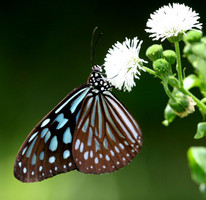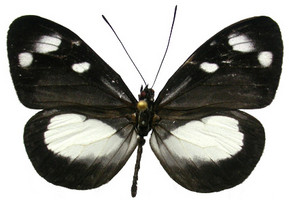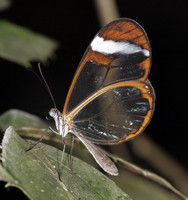Danainae
Niklas Wahlberg and Andrew V. Z. Brower


This tree diagram shows the relationships between several groups of organisms.
The root of the current tree connects the organisms featured in this tree to their containing group and the rest of the Tree of Life. The basal branching point in the tree represents the ancestor of the other groups in the tree. This ancestor diversified over time into several descendent subgroups, which are represented as internal nodes and terminal taxa to the right.

You can click on the root to travel down the Tree of Life all the way to the root of all Life, and you can click on the names of descendent subgroups to travel up the Tree of Life all the way to individual species.
For more information on ToL tree formatting, please see Interpreting the Tree or Classification. To learn more about phylogenetic trees, please visit our Phylogenetic Biology pages.
close boxIntroduction
The name Danainae is here applied to the clade inclusive of the pantropical milkweed butterflies ("Danaidae" of authors), the neotropical clearwing butterflies ("Ithomiidae" of authors), and the monogeneric Australasian Tellervo, which has commonly been accorded subfamilial rank. Larvae of all three possess thoracic tubercles and are associated with apocynaceous larval hostplants, at least among basal members of each group. All are aposematic as adults and many serve as models or co-mimics in mimicry complexes.
Discussion of Phylogenetic Relationships
These groups have traditionally been united by similarities of hostplant use–basal members of each group are associated with Asclepiadaceae and/or Apocynaceae (Ackery 1988). Molecular evidence supporting their close relationship has been found by Brower (2000), and morphological synapomorphies by Freitas and Brown (2004).
References
Ackery PR. 1988. Hostplants and classification: a review of nymphalid butterflies. Biol. J. Linn. Soc. 33: 95-203.
Brower AVZ. 2000. Phylogenetic relationships among the Nymphalidae (Lepidoptera) inferred from partial sequences of the wingless gene. Proc. R. Soc. Lond. B 267: 1201-1211.
Freitas AVL, and Brown KSJ. 2004. Phylogeny of the Nymphalidae (Lepidoptera). Systematic Biology 53: 363-383.
Title Illustrations

The photos above illustrate representatives of the three danaine clades:
- Danaini: Ideopsis (left)
- Tellervinini: Tellervo (center)
- Ithomiini: Greta (right)
| Scientific Name | Ideopsis similis |
|---|---|
| Location | Taiwan |
| Specimen Condition | Live Specimen |
| Source | IMG_7755al1 |
| Source Collection | Flickr |
| Image Use |
 This media file is licensed under the Creative Commons Attribution-NonCommercial-NoDerivs License - Version 2.0. This media file is licensed under the Creative Commons Attribution-NonCommercial-NoDerivs License - Version 2.0.
|
| Copyright | © 2006 leemt2 |
| Scientific Name | Tellervo zoilus |
|---|---|
| Location | Queensland, Australia |
| Specimen Condition | Dead Specimen |
| Identified By | Darrell Kemp |
| Image Use |
 This media file is licensed under the Creative Commons Attribution-NonCommercial License - Version 3.0. This media file is licensed under the Creative Commons Attribution-NonCommercial License - Version 3.0.
|
| Copyright |
© Niklas Wahlberg

|
| Scientific Name | Greta morgane |
|---|---|
| Location | captive, Bedford Butterfly Park |
| Specimen Condition | Live Specimen |
| Source | Glass Wing |
| Source Collection | Flickr |
| Image Use |
 This media file is licensed under the Creative Commons Attribution-NoDerivs License - Version 2.0. This media file is licensed under the Creative Commons Attribution-NoDerivs License - Version 2.0.
|
| Copyright | © 2006 Bill Hails |
About This Page
Niklas Wahlberg

University of Turku, Finland

Middle Tennessee State University, Murfreesboro, Tennessee, USA
Correspondence regarding this page should be directed to Niklas Wahlberg at and Andrew V. Z. Brower at
Page copyright © 2009 Niklas Wahlberg and
 Page: Tree of Life
Danainae .
Authored by
Niklas Wahlberg and Andrew V. Z. Brower.
The TEXT of this page is licensed under the
Creative Commons Attribution License - Version 3.0. Note that images and other media
featured on this page are each governed by their own license, and they may or may not be available
for reuse. Click on an image or a media link to access the media data window, which provides the
relevant licensing information. For the general terms and conditions of ToL material reuse and
redistribution, please see the Tree of Life Copyright
Policies.
Page: Tree of Life
Danainae .
Authored by
Niklas Wahlberg and Andrew V. Z. Brower.
The TEXT of this page is licensed under the
Creative Commons Attribution License - Version 3.0. Note that images and other media
featured on this page are each governed by their own license, and they may or may not be available
for reuse. Click on an image or a media link to access the media data window, which provides the
relevant licensing information. For the general terms and conditions of ToL material reuse and
redistribution, please see the Tree of Life Copyright
Policies.
- First online 25 September 2006
- Content changed 27 October 2008
Citing this page:
Wahlberg, Niklas and Andrew V. Z. Brower. 2008. Danainae . Version 27 October 2008 (under construction). http://tolweb.org/Danainae/12187/2008.10.27 in The Tree of Life Web Project, http://tolweb.org/











 Go to quick links
Go to quick search
Go to navigation for this section of the ToL site
Go to detailed links for the ToL site
Go to quick links
Go to quick search
Go to navigation for this section of the ToL site
Go to detailed links for the ToL site